

Meo di Guido obviously came from Siena, but the identity of his father is not clear, since there were a number of artists in that city named Guido in the relevant period. One documentary reference to Meo di Guido survives: a record of a transaction in 1319 reveals that he had recently become a citizen of Perugia. In addition, one signed work is known: the Montelabate Polyptych (ca. 1315) - see below.
Perugia
Madonna and Child (ca. 1310)
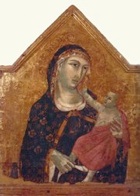
Montelabate Polyptych (ca. 1315)
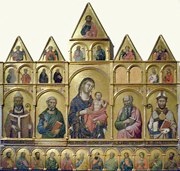
This polyptych, which is signed by Meo di Guido, came from the high altar of the Abbazia di Santa Maria di Valdiponte, Montelabate, outside Perugia. It was dismembered in the late 18th century, after which time the panels were displayed separately in various parts of the church. Most of the panels entered the Accademia di Belle Arti in 1810: however, the central panel and the predella remained in the church until 1863, when most of the surviving panels were reunited in the Galleria Nazionale. The panel of St Peter passed into private ownership at some point, and was acquired by the gallery in 1968.
The polyptych seems to have been inspired by Duccio’s contemporary work, including his polyptych for San Domenico, Perugia (now also in the Galleria Nazionale).
-
✴The central panel depicts the Madonna and Child, with two prophets above above and Christ the Redeemer in the gable.
-
✴The side panels, each of which has an angel in the gable, depict:
-
•St Gregory, with SS Martha and Catherine of Alexandria above;
-
•St Peter, with SS Antony Abbot and Benedict above;
-
•St John the Evangelist, with the saints above missing; and
-
•St Emilian, with SS Agnes and Mary Magdalene above.
-
✴The predella depicts the twelve apostles.
Triptych (ca. 1315)
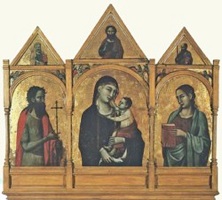
This triptych, which is attributed to Meo di Guido, survives in its original frame. It was probably commissioned for San Domenico Vecchio. It is now in the Museo Capitolare (Room 15).
Madonna and Child (1325-30)
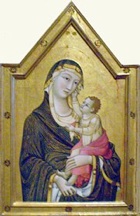
Double-sided altarpiece (1330?)
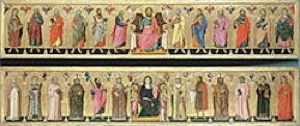
This altarpiece, which is attributed to Meo di Guido, came from the high altar of San Pietro. The inscription records that it was commissioned in 1333, "in the time of Abbot Ugolino". This was possibly Ugolino di Nuccio da Montevibiano, who was abbot in the period 1330-57. However, it seems that the date was originally given as 1330, in which case it was commissioned by Ugolino Vibi Guelfoni da Gubbio, who was abbot in the period 1305-30.
-
✴One side of the altarpiece depicts the Madonna and Child enthroned with angels, flanked by saints whose relics the monastery possessed. The donor, Abbot Ugolino is portrayed in his white Benedictine habit, kneeling at the foot of the throne.
-
✴The other side of the altarpiece depicts Christ enthroned, flanked by the twelve Apostles.
The altarpiece was probably removed from the high altar in 1436. Its two sides, which were separated in the 18th century, remained at San Pietro until the 1830s. They are now in the Städelsches Kunstinstitut, Frankfurt.
Return to Art in: Perugia.

